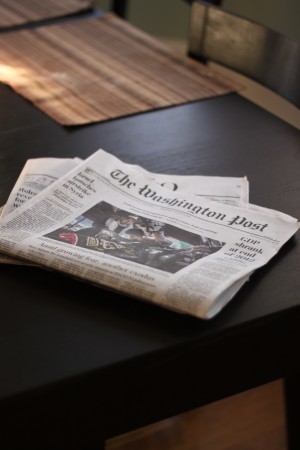We must hold the Bible in one hand and the newspaper in the other. – Karl Barth
 Every morning I wake up, make my tea, and sit down at the breakfast table with the latest edition of The Washington Post. I usually read the A Section, news about what is happening in across the nation and around the world.
Every morning I wake up, make my tea, and sit down at the breakfast table with the latest edition of The Washington Post. I usually read the A Section, news about what is happening in across the nation and around the world.
Reading the paper might not be the most relaxing morning activity I could choose. As my wife Faith can attest, I frequently get into arguments with the Post. I notice editorial slants in supposedly fact-based articles. I observe the selection of where different stories are placed – and what news even gets coverage at all. I try to see the story behind the story, even when the storytellers get in the way.
When I read the newspaper, I know that I can’t simply accept everything I read at face value. Even when all the facts are correct, different parts of the story are highlighted with intention. What’s important to the writers at The Washington Post is not always what I consider most important. Sometimes, mere facts can be employed to hide the truth.
After I finish my tea and newspaper, I move to the living room for my morning devotions. This often involves reading the Bible. What a contrast to The Washington Post! Rather than reading with skepticism, I can let down my guard and engage the text with trust. Just like the Post, the authors of the Bible have an agenda. Different texts are edited and arranged in a certain order. Facts are presented in a particular way. Stories are told with the objective of communicating a certain worldview.
When I read the newspaper, I’m not always sure whose worldview I’m being fed. With the Bible, I can trust that it is God’s. The texts of Scripture have no veneer of journalistic objectivity. The writers of the law, the prophets, the gospels and the epistles never pretend that they are speaking from a neutral point of view. They want me to believe; and believing, to act.
Despite the undisguised agenda of the biblical writers, the story that they tell is true. The bias of Scripture is divine bias. When Jesus shows love to the outcast and the poor, this demonstrates God’s characteristic way of seeing the world. When John writes of a new heaven and a new earth, I am shown God’s intention for the healthy, fully mature society that we all long for – and which all human leaders promise on their rise to power.
 This heavenly story helps me read The Washington Post without being enthralled to its earthly worldview. I read of wars and rumors of wars, of great empires vying for power and politicians jockeying for position. I read of the ambition of the rich, and occasionally of the struggles of the poor. The newspaper immerses me in the story of modern-day human achievement; the Bible tells me an alternative story, one which pulls back the curtain on the power-plays of this world and reveals the humble-yet-mighty reign of God that lies just behind the headlines.
This heavenly story helps me read The Washington Post without being enthralled to its earthly worldview. I read of wars and rumors of wars, of great empires vying for power and politicians jockeying for position. I read of the ambition of the rich, and occasionally of the struggles of the poor. The newspaper immerses me in the story of modern-day human achievement; the Bible tells me an alternative story, one which pulls back the curtain on the power-plays of this world and reveals the humble-yet-mighty reign of God that lies just behind the headlines.
The biblical story is a lodestone that allows me to engage with the stories of my culture without being taken in by them. God uses the Scriptures to break through the false objectivity of my present-day assumptions. It helps me to acknowledge that I do, in fact, live within a worldview – not some neutral zone of self-evident truth. The Bible reveals to me that I have to make a decision. Whether I choose the kingdom of God or the kingdoms of this world, there is no neutral ground to stand on.
How do you find your place to stand? Are you able to tell the difference between mere data and truth that is worth taking risks for? What are ways that you find the truth behind the headlines?